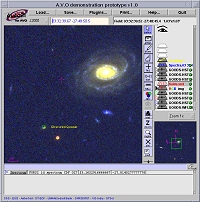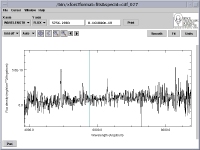AVO - First Science
The AVO demonstration this year dealt with an extragalactic case on obscured quasars, centred around the Great Observatories Origin Deep Survey (GOODS) public data, and a Galactic scenario on the classification of young stellar objects. New features, compared to last year's demonstration, included:
- support of spectroscopic data, with direct links between imaging and spectral data of the same sources
- seamless and transparent access to scientifically validated products from the ISO and XMM-Newton archives
- usage of new standards: Simple Image and Simple Spectrum Access
- usage of new tools: SpecView, Hyper-z, VOPlot, and a cross-matching package
The extragalactic scenario resulted in the discovery of about 40 new obscured quasar candidates, as compared to the 9 previously known in the same fields used for the demonstration.
 |
 |
|
An obscured quasar imaged by the Hubble Space Telescope Advanced Camera for Surveys (left, labelled source) and identified through an ESO/FORS2 spectrum (right) | |
The highlight of the demonstration was the fact that AVO is already starting to do cutting-edge science by allowing the exploitation of astronomical data beyond the "classical" identification limits. Astronomers are quickly moving beyond the era when source identification was done by taking a spectrum with a telescope, into an era when classification is achieved by using all the multiwavelength information available.
The AVO development
The breathtaking capabilities and ultra-high efficiency of new ground- and space-based observatories have led to a data explosion calling for innovative ways to process, explore, and exploit these data. The Virtual Observatory (VO) is an innovative, evolving system that allows users to interrogate multiple data centres in a seamless and transparent way using new international standards for archiving and data-mining protocols. The VO initiative is a global collaboration of the world's astronomical communities under the auspices of the recently formed International Virtual Observatory Alliance (IVOA).
The AVO project is conducting a research and demonstration programme on the scientific requirements and technologies necessary to build a VO for European astronomy. The AVO has been jointly funded by the European Commission (under the Fifth Framework Programme [FP5]) with six European organizations participating in a three year Phase-A work programme.
The partner organizations are:
- ESO in Munich
- ESA
- AstroGrid, funded by PPARC as part of the United Kingdom's
E-Science programme - the CNRS-supported Centre de Données Astronomiques de Strasbourg (CDS) and TERAPIX astronomical data center at the Institut d'Astrophysique in Paris
- the University Louis Pasteur in Strasbourg
- Jodrell Bank Observatory of the Victoria University of Manchester
After Phase-A, the project will move towards the EURO-VO, that is the full-fledged 4-year European VO programme. The AVO Phase A program is focusing its efforts on a description of the science requirements for the AVO, data and archive interoperability and the necessary database technologies needed for a full EURO-VO implementation. As a coordinated effort, the IVOA partners are holding demonstrations of new VO capabilities on an annual basis.
Download the AVO prototype
The AVO prototype used during the demonstration can be downloaded from the AVO pages at http://www.euro-vo.org/twiki/bin/view/Avo/SwgDownload. This page also contains detailed instructions on how to reproduce the AVO science demonstration, both the extragalactic and Galactic scenarios. We encourage astronomers to download the prototype, test it, and also use it for their own research!
(Please note that this is still a prototype: although some components are pretty robust some others are not.)
Contact
For any problem, request, question, feedback, and comment you might have regarding the AVO protoype and installation please contact the AVO team at twiki euro-vo.org
euro-vo.org
For any other AVO science related matter please contact Paolo Padovani (Paolo.Padovani eso.org), manager of the AVO Work Area 1 (Science).
eso.org), manager of the AVO Work Area 1 (Science).

